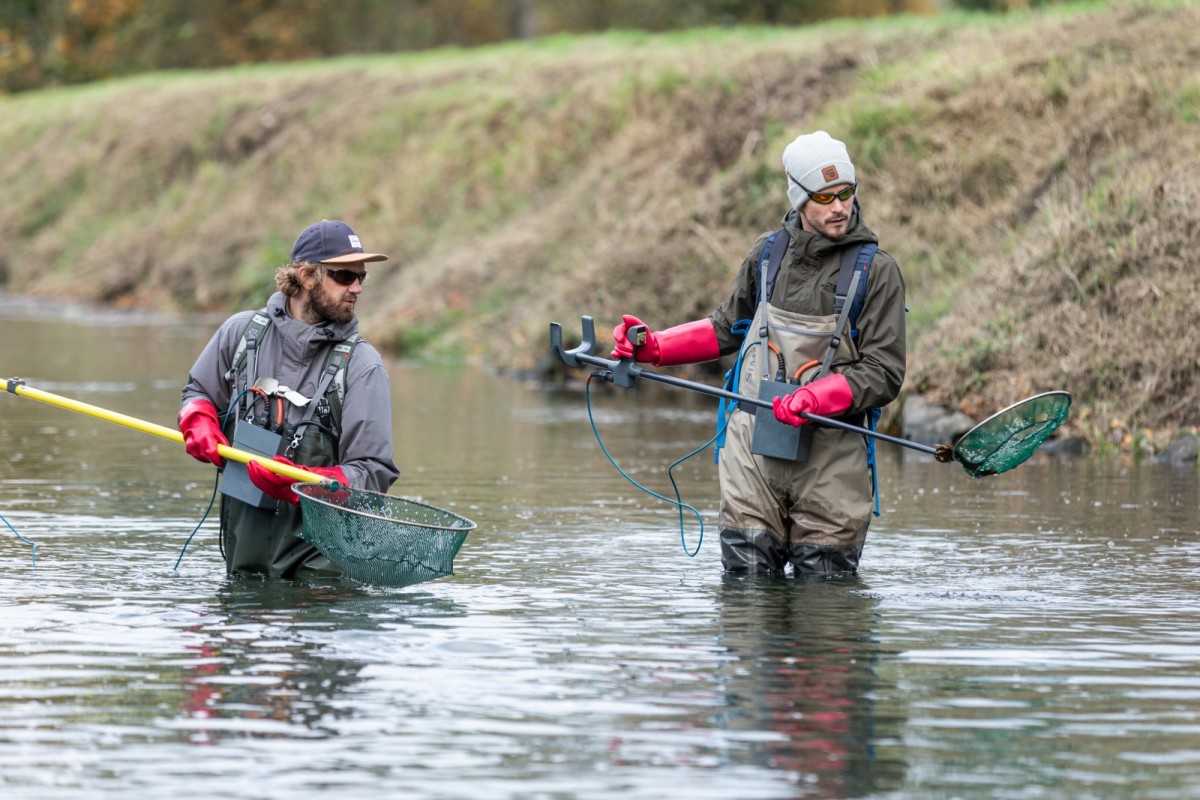
Stunned fish
The European bullhead, spined loach or river trout are species of fish only rarely encountered in the River Aa in Münster. The river, 43 kilometres in length, has been in a bad status for many years now, and straightening measures, land drainage, reservoirs, agriculture and waste-water effluents have all left their mark on the river. Researchers from the University of Münster want to find out more and are now examining the hydrochemical and biological condition of the Aa. The project is headed by Prof. Tillmann Buttschardt, from the Institute of Landscape Ecology, and is being funded by the German Federal Environmental Foundation (Deutsche Bundesstiftung Umwelt, DBU).
Over the past few years, the water ecology experts have driven out dozens of times to numerous locations in the 172 m2 catchment area of the River Aa in order to collect data. In their work they chart fish stocks and macrozoobenthos, which include small organisms such as crabs or mussels. In one part of the project, headed by Prof. Christine Achten from the Department of Applied Geology at Münster University, special hydrochemical parameters are recorded such as traces of pesticides or residues of medicinal products.
In order to determine the diversity, age structures and numbers of the fish, the scientists undertake electrofishing, with the approval of the relevant local Nature Conservation Agency in each case. An electrofishing device conducts an electrical current of up to six amps through the water. Fish which find themselves in the electrical field swim towards the anode and are gathered in by means of a net, then identified and measured. “This is a very gentle way of catching fish,” says project team member Patrick Günner from the Institute of Landscape Ecology. “The fish are stunned for just a few seconds and carry on swimming after being examined.”
The fishing takes place in the spring and the autumn, as the Aa has enough water at these times, the water temperature is not too high, and as a result the fish are not exposed to any additional stress. “This autumn is the last time that we’ll be fishing in the Aa,” says Michel Harre, a landscape ecology student. “Afterwards the data are analysed, and we compare all the values with one another and evaluate the interaction between the chemical and the ecological condition of the river.” His fellow student Sam Lucy Behle adds, “Today we caught more than 500 fish on a 400-metre stretch of the river – including some species, for example the common roach and the common dace, which are typical of north German lowland rivers, of which the Aa is one. We also found bitterlings and European bullheads. These are protected species which are only rarely found in the Aa.”
“The results help in developing a decision support system for water policy at the river catchment area level,” says Tillmann Buttschardt, head of the Applied Landscape Ecology and Ecological Planning research group. “This includes having an integrated concept with tailor-made measures for the protection and management of the Aa and its tributaries.”
As far back as the mid-1980s, experts were first thinking about the renaturation of water bodies. But it was only after the European Water Framework Directive (WFD) came into force in 2000 that a legal framework for water policy was created. For the Aa – as an “artificial and heavily changed water body” – this means that a “good ecological potential” was be achieved by 2027.
In the researchers’ view, it will be very difficult – if not impossible – to reach this goal in the coming seven years. Effluents such as nitrogen and phosphorous are environmentally harmful for the water in the Aa’s catchment area. In addition, many water bodies display structural deficits which mean that various species of biota typical of water bodies do not find the necessary conditions for permanent settlement.
“Pressure is rising to revert water bodies back to their natural states in order to achieve the aims set by the WFD,” says Carsten Bohn from the Westfalen-Lippe Association of Water and Land Authorities and Partners in Practice. Tillmann Buttschardt has been dealing with ecological planning for the environment and for water bodies for many years now, and, as he says, “It is not easy to reconcile the interests of nature conservation, water management systems, agriculture and flood protection. And the Münsterland, a region characterized by agriculture, is particularly dependent, economically, on arable land and grassland areas. In other words, any measures will have to be drawn up with the participation of everyone involved.”
“In planning any measures,” says Carsten Bohn, “we take into account the so-called Species-habitat-network concept. ‘High quality habitats and in the river continuum embedded stepping stones’ describe the unspoilt areas and structural elements of a water body which facilitates networking between habitats and safeguards the survival of various species of fauna and flora.”
Just what this can look like is shown by the renatured section of the water body along the grassland (‘Westholtsche Wiese’) in the vicinity of the central swimming baths in Münster. There, the Aa has recently started to flow again in a bed full of riverbends. Gravel deposits, sandbanks and deadwood are used by the creatures living there as habitats typical of water bodies. However, it will be some years before the experts can say what effect these measures will have on fish populations, water quality and flood protection in the medium and long term.
This article first appeared in the University newspaper wissen|leben, No. 7, 11 November 2020.


